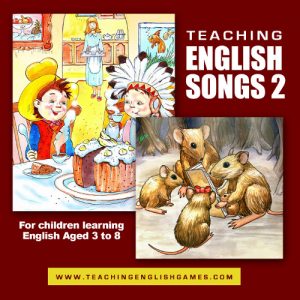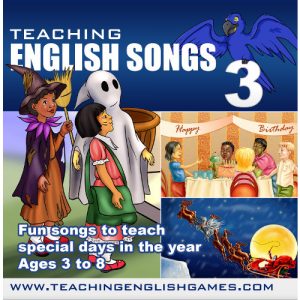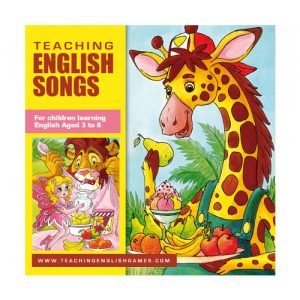Why English teachers should be using ESL songs in class and how to do it successfully
Many teachers already know that teaching English through songs brings joy to the classroom. This article looks at why songs benefit pupils and how to use them in a fun and productive way. Read on for insight and prepare to be motivated to use music with your ESL students!
First, we’ll take a look at the incredible benefits of using songs as a part of ESL teaching. Then we’ll consider some of the problems teachers encounter using ESL songs, which discourage them from continuing. Finally, we will learn how songs can be used successfully, so that your pupils learn faster, enjoy your classes more and really can sing along!
The incredible benefits of teaching English through songs
1. Songs help learn vocabulary, grammar, and syntax
Learning with songs works because children hear whole sentences and absorb grammar and syntax subconsciously. It’s an easy way for them to learn and remember words and phrases.
2. They can use meaningful language in context
Children hear vocabulary and phrases in a natural and meaningful context and no longer as isolated words or sentences.
3. Songs can be catchy and re-usable
Unlike listening comprehension, a song is catchy and fun, and ESL students will be happy hearing it many times over several months, as long as you don’t play it to death in a single lesson.
4. Songs enhance listening skills
Naturally, listening to any English song helps listening skills as long as the language is within the learner’s grasp.
5. They improve speaking fluency with the natural rhythms of language
When teaching English through songs, it’s best to use recordings by native speakers. This way, students hear natural rhythms and stress, which helps their pronunciation and speaking fluency.
6. Appeal to broader learning styles
Use actions to go with each song. Any song can have appropriate actions, not just obvious ones like Head Shoulders Knees and Toes. Incorporating movement and mime pushes the boat out to reach more pupils by encompassing various learning styles in class.
Kinesthetic and tactile learners will latch on to using their bodies to the music while Auditory learners are in their element listening. Visual learners see others making the actions and can look at story pictures or vocabulary flashcards relating to the song. Everybody is happy, except for the tiny minority of people who do not like music!
7. Songs are fun and motivate pupils
Only at number seven on this list, but a tremendous benefit is that using music can lift the atmosphere in class, bring in a boost of energy and zest for life that captures the children’s attention and motivates them in their quest to learn English.
8. Songs can be confidence building
Teaching English through songs is a way for children to listen and practice English in a group, joining in when they can without being singled out and gradually achieving more with each listening. Learners can gain a massive boost in confidence from this, which percolates through to all learning.
9. Songs are memory aids
We all know how songs can stick in our head, which is precisely what we want for our English language learners.
10. Songs help with classroom management
More mundane but crucial to a teacher is that putting on a song attracts pupils’ attention right away. Everyone joins in with the actions and starts to sing along. The teacher now has their attention if they did not before!
In summary, teaching English through songs allows pupils to hear English in context, naturally. Students can listen to piece repeatedly, get involved with TPR activities (total physical response), and enjoy learning. Songs can help them focus and motivate them to remember and retain the language. Music also helps with classroom management.
Problems with teaching English through songs
So with all these wonderful benefits of teaching English through songs, why don’t more teachers use them more often? The obvious problem is that many English songs are hopeless for ESL learners. Most English songs have too many words since they are written for native speakers, so young ESL beginners cannot sing along.
Secondly, many popular songs have inappropriate content for the classroom – at least in many cultures.
Thirdly, what can you do about the children sitting there like lemons while the music plays? And, because the words are so complicated and fast, you have to play the song to death before the children can have any hope of following it. Before you get to that stage, they’ll be emitting a groan that says, “oh, not that song AGAIN – can’t you see we are SICK of it!”
Teaching English through songs successfully
Firstly it goes without saying that you need the right kind of song. If you choose music that is too fast or difficult, your pupils are likely to glaze over, become distracted, and in the worst case, become demoralized by their failure to follow the song.
1. It would help if you had songs specific to ESL
English songs for native speakers are fine as background music while you do other activities or games. But, if your aim is for your pupils to sing along to the song, then you need something with simpler words that are repetitive.
My song albums are written primarily for young English language learners:
Songs 1 Songs 2 Songs 3 for Special Days
2. How to teach English through songs
Songs can be used as background music for other activities, which is a good strategy when teaching two-year-olds.
However, from three and up, more structured teaching methods are also an option. Here is an example of how to teach a song:
a. Start with key vocabulary
Start by teaching the target vocabulary using games and flashcards, which might take an entire lesson. Once pupils recognize the main words, introduce any key phrases so that children may use the new vocabulary in context.
b. Use background music
Students can hear the song a couple of times as background music while playing listening games to learn or practise vocabulary. Hearing the music helps them become familiar with the melody and rhythms even though they may not understand the words at this point. Previews like this help when it comes to listening to the song attentively for the first time.
c. Use language games with the song
Start with a game where pupils focus on specific words they hear. For example, a game might be to run and jump on a flashcard of a noun, or point at it, when they hear that noun sung. Or, you might stick four or five flashcards of nouns from the song on the board and ask the children to listen and clap whenever they hear one of those words.
d. Keep it fresh
After listening to the song twice using two different listening games, set it aside until the next class. This keeps it fresh. Review the vocabulary at the next lesson, perhaps learn some new words and re-visit the song. This time you might work on some actions to put to the lyrics.
e. Invent actions
One idea is to make a unique action for essential nouns. For example, if the song has ‘apple’ in it, pretending to bite into an apple or making a circle with your hands could be a suitable action for that word. Verbs and adjectives are ideal for mimes. Actions can portray meaning and also may be purely for the sake of moving to the music. In any case, with a teeny bit of imagination, anyone can make up actions for any song! Remember that your pupils are a well of inspiration and would be honored to give you ideas.
There are a host of options. If you would like ideas, check out my various publications on ESL games and activities, particularly for young learners. At any rate, never expect the children to sit there passively. On the contrary, it’s preferable to engage them with a specific task while listening, as this keeps them focused and eager.
f. Practise saying the lines in rhythm
In the next lesson, out comes the song again for a short time. This time you might have a session saying the words in the rhythm of the music, then repeat this and add the actions you put together in the last lesson. Finally, finish playing the song once with children doing the actions and attempting to join in where we can.
g. Break down the difficulty
If you like singing, you might want to rehearse the tune with the children line by line. If a line is long, break down the difficulty and sing the first half only (with any actions), and let the children sing that back to you two or three times. Then add on the second half. Wherever you see the children struggling, SIMPLIFY – break down the difficulty into manageable chunks and sing SLOWER than the actual song if necessary at first.
h. Re-visit the song to perfect it and review
Gradually the song will come together in a fun, non-threatening way while keeping the music fresh. Put the piece to rest once it has been well-learned and preferably performed to parents or other classes. Generally, people like to move on to new things, as it can become stale to be looking at the same themes endlessly. It’s better to settle for something quite good and move on rather than flog it to death seeking perfection. Children will be happy to review the song if you have kept it fresh for them, which is why I prefer to teach a play or music over a series of lessons rather than doing it in a block. Of course, with faster learners, you will be able to finish in a single session, but with an average group of preschool beginners, this would be a feat indeed!
After teaching the song, as described above, to primary school students, use the lyrics to work on reading, spelling, and writing skills.
3. Ideal songs for preschool ESL and early primary
To help preschool ESL teachers, I have created a curriculum for preschool learners based on games, stories, and related songs. Teachers work through the twenty illustrated stories, sing and act out songs that cover the same topics, and even have the same characters. The songs are specially created for young ESL learners aged 3 to 6, although they do appeal to older children. The language is simple, repetitive and children learn it by heart quickly, much to the surprise and delight of many teachers and parents. This resource includes everything a teacher needs; vocabulary flashcards, story illustrations, masks to make and wear for acting, games to teach the language, and the music itself.
To listen to these fun songs specially written for ESL, please click on the album of your choice below:
-
Sale Product on sale
 Songs 2 (audio + video + karaoke + masks)
Songs 2 (audio + video + karaoke + masks)€19.97Original price was: €19.97.€9.97Current price is: €9.97. -
Sale Product on sale
 Songs 3 (audio + karaoke + masks)
Songs 3 (audio + karaoke + masks)€16.00Original price was: €16.00.€9.97Current price is: €9.97. -
Sale Product on sale
 Songs 1 (audio + video + masks + activities)
Songs 1 (audio + video + masks + activities)€19.97Original price was: €19.97.€9.97Current price is: €9.97.



